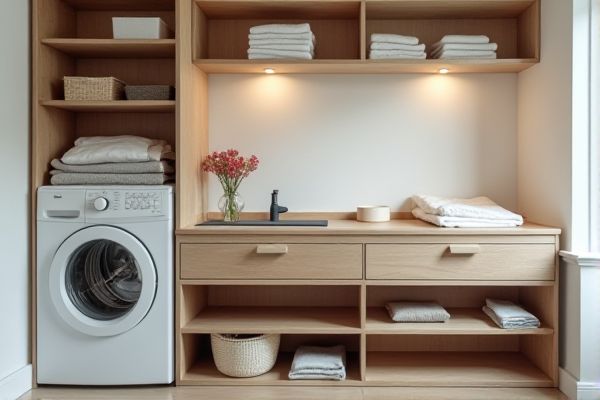
Stacked folding stations maximize vertical space by allowing clothes to be folded on multiple levels, making them ideal for compact laundry rooms, while wall folding stations save floor space by mounting directly on the wall and providing a large, flat folding surface at a comfortable height. Explore the full article to determine which folding solution best fits Your laundry room needs and lifestyle.
Table of Comparison
| Feature | Stacked Folding Station | Wall Folding Station |
|---|---|---|
| Installation | Floor-mounted, requires more space | Wall-mounted, saves floor space |
| Space Efficiency | Lower efficiency due to footprint | High space efficiency, ideal for small rooms |
| Accessibility | Easy access from multiple sides | Limited side access, depends on wall placement |
| Capacity | Typically supports heavier loads | Better for lighter, smaller folding tasks |
| Maintenance | Simple to maintain with open access | Requires more effort due to mounted position |
| Cost | Generally higher installation cost | Usually lower installation and space costs |
Introduction to Folding Stations
Stacked folding stations maximize space by allowing you to fold laundry directly on multiple levels, enhancing efficiency in compact areas. Wall folding stations offer a sleek, fold-away design that saves floor space and integrates seamlessly into laundry rooms. Choosing between the two depends on your available space and preferred workflow for optimal laundry organization.
What is a Stacked Folding Station?
A Stacked Folding Station features multiple foldable surfaces arranged vertically, maximizing workspace in compact areas. Unlike a Wall Folding Station, which mounts flat against a wall and folds down for use, the stacked design allows for several folding levels simultaneously, enhancing task organization and efficiency. Your choice depends on space requirements and workflow preferences for optimal productivity.
What is a Wall Folding Station?
A wall folding station is a compact, space-saving unit mounted directly onto a wall, designed to provide a convenient surface for folding laundry. Unlike stacked folding stations that occupy floor space by combining multiple functions vertically, wall folding stations free up room in small laundry areas by folding flat against the wall when not in use. This makes them ideal for maximizing efficiency in tight spaces while maintaining a functional folding surface.
Space Efficiency: Stacked vs Wall Folding Stations
Stacked folding stations maximize vertical space by allowing multiple units to be placed one above another, making them ideal for limited floor areas. Wall folding stations optimize wall space by folding flat against the wall when not in use, freeing up the floor for other activities. Your choice depends on whether you prioritize floor space conservation or utilizing vertical or wall areas for efficient workspace management.
Installation and Setup Requirements
Stacked folding stations require more floor space and precise alignment during installation to ensure stability and efficient operation, making setup more involved compared to wall folding stations. Wall folding stations mount directly onto vertical surfaces, minimizing floor space usage and simplifying installation with fewer anchoring points needed. Both types demand accurate measurements, but wall folding stations benefit from quicker setup times due to their compact design and straightforward mounting process.
Durability and Material Comparison
Stacked folding stations often feature heavy-duty steel frames and reinforced joints, providing superior durability suited for high-traffic environments. Wall folding stations typically use lighter materials such as aluminum or engineered wood, offering moderate durability but less resistance to heavy or frequent use. Your choice should consider the balance between the robust construction of stacked stations and the space-saving benefits of wall-mounted designs.
User Accessibility and Ergonomics
Stacked folding stations provide enhanced user accessibility by allowing multiple surfaces at varying heights, reducing the need to bend or stretch frequently, which supports better ergonomic posture during prolonged tasks. Wall folding stations optimize space and are ideal for smaller areas but may require awkward reaching or bending, potentially causing strain over time. Choosing a stacked folding station can improve your comfort and efficiency by promoting natural body alignment and minimizing repetitive stress.
Cost Analysis: Stacked vs Wall Folding Stations
Stacked folding stations typically incur higher initial costs due to their complex design and increased material requirements, but they maximize vertical space, reducing overall footprint expenses. Wall folding stations offer a more budget-friendly solution with simpler installation and lower maintenance costs, making them ideal for smaller operations or tight spaces. When evaluating cost efficiency, stacked stations provide long-term savings through enhanced workflow and space optimization, whereas wall stations minimize upfront investment and are cost-effective for limited-volume use.
Ideal Use Cases for Each Folding Station Type
Stacked folding stations are ideal for high-volume laundry environments where space optimization and quick turnaround times are essential, such as commercial laundries and industrial settings. Wall folding stations suit smaller spaces or home laundry rooms where saving floor space is a priority, offering convenience and functionality without compromising room for other activities. Your choice depends on whether you prioritize maximized efficiency for large loads or compact design for limited space.
Choosing the Right Folding Station for Your Needs
Stacked folding stations maximize space efficiency by providing multiple levels for folding, ideal for limited areas requiring high productivity, while wall folding stations offer a compact, fold-away design that saves floor space and suits smaller or mobile setups. Selecting the right folding station depends on workspace size, workflow demands, and storage preferences, with stacked models favoring multi-user environments and wall stations benefiting single-user or minimalist applications. Consider ergonomic access and installation requirements to optimize folding efficiency and maintain organized operations.
 homyna.com
homyna.com